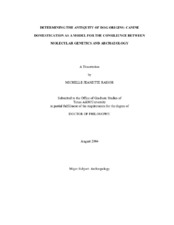| dc.description.abstract | Archaeologists have favored a date of 14,000-15,000 years before present (BP) for canine domestication. However, recent studies of mutations in the mitochondrial DNA sequence by molecular geneticists have implied that dogs were domesticated over 100,000 years ago, which has challenged traditional theory. Geneticists have further hypothesized that dogs originated from wolf ancestors based upon the number of substitutions observed in dog and wolf haplotypes. Although both disciplines provide substantial evidence for their theories, the origin of dog domestication remains controversial. Several areas continue to be debatable. First, both geneticists and archaeologists incorrectly use the term domestication to describe events that clearly can not be proven to under human control. Second, the evolutionary development of canines is viewed by molecular biologists as well as archaeologist to be indicators of domestication without any further exploration of other probable causes. Third, the studies in canine genetics are so complex that most archaeologists have difficulty in providing evidence that would be contradictory to molecular theory. Fourth, both fields of study continually ignore innate behavioral characteristics of wolves that would make domestication highly improbable. Fifth, geneticists rely heavily on data gathered from sequencing of mitochondrial DNA, which has been assumed to maternally inherited. However recent human studies have shown that this assumption has now been proven to be incorrect. And finally, not only are morphological traits of fossilized dogs and wolves so similar that making a taxonomic identification improbable, but also the amount of archaeological remains available are too sparse and fragmented for accurate affiliation.
An alternate theory of canine domestication will be proposed utilizing data gathered from the archaeological record and molecular research. I hypothesize that dogs diverged naturally from wolves 100,000 years ago as a result of the natural course of evolution, not human intervention, and had already evolved into a dog prior to being domesticated by humans 14,000-15,000 years ago. Evidence will be presented to clearly show that this hypothesis is a more accurate scenario of canine domestication. | en |


